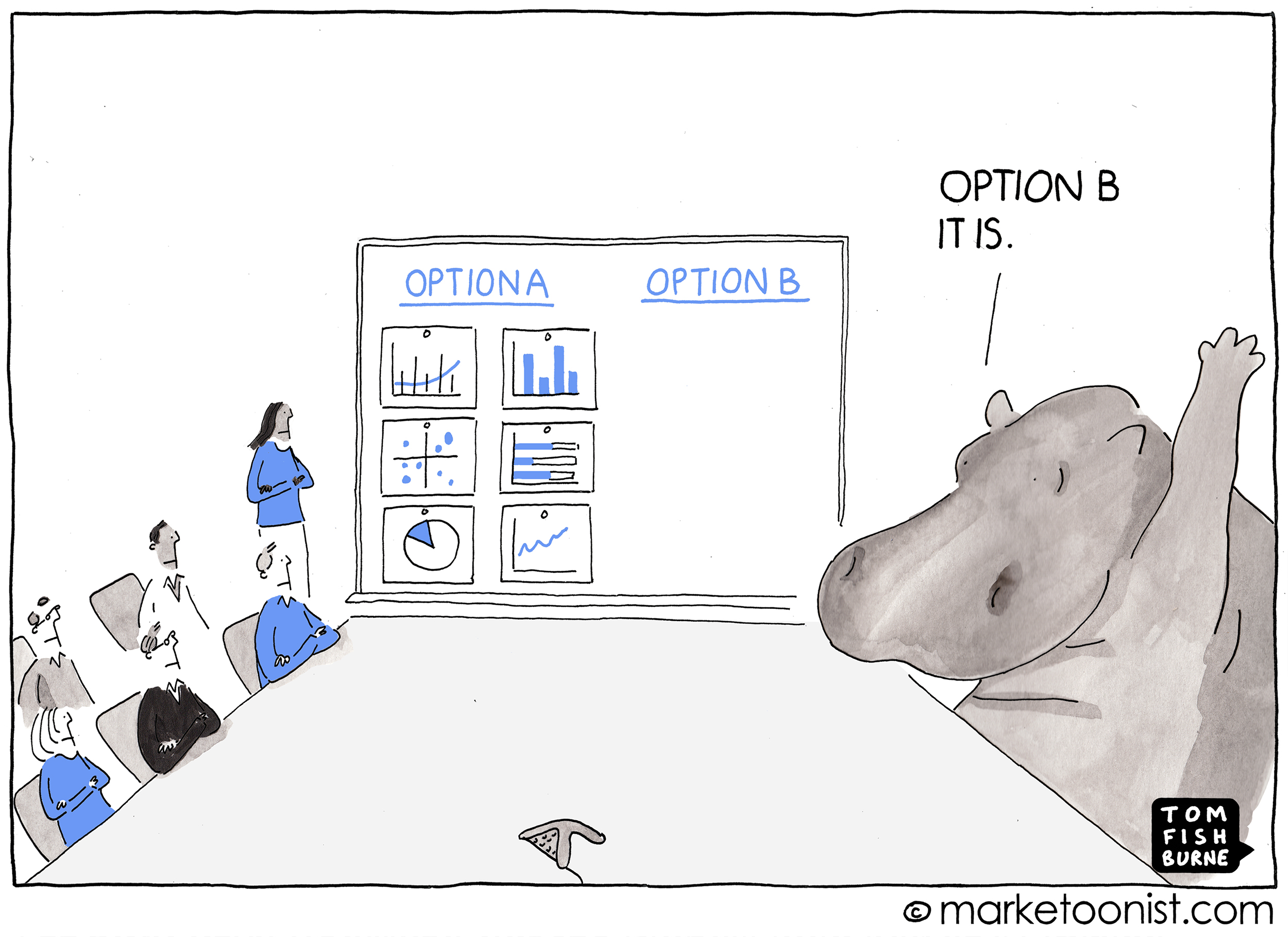
In this article, we’ll answer the question, “What is Agile Marketing?” Why should you use Agile marketing? What are the limitations of Agile marketing? How do you get started with Agile marketing? What are some of the best resources to help you learn, adopt, and grow with Agile Marketing?
If you want to jump to a particular topic, click on one of the sections below:
Table of Contents
What is Agile Marketing?
Agile Marketing is an approach to marketing that takes its inspiration from Agile software development and that values:
- Focusing on customer value and business outcomes over activity and outputs
- Delivering value early and often over waiting for perfection
- Learning through experiments and data over opinions and conventions
- Cross-functional collaboration over silos and hierarchy
- Responding to change over following a static plan
These values come from the Agile Marketing Manifesto.
Agile Marketing also has a set of principles which elaborate on the values:
- Great marketing requires close alignment, transparency, and quality interactions with internal and external customers
- Seek out different and diverse points of view
- Embrace and respond to change to enhance customer value
- Plan only to a level sufficient to ensure effective prioritization and execution
- Take chances, and learn from your failures
- Organize in small, cross-functional teams where possible
- Build marketing programs around motivated individuals and trust them to get the job done
- Long-term marketing success benefits from operating at a sustainable pace
- Agile marketing isn’t enough. Excellence in marketing requires continuous attention to marketing fundamentals as well
- Strive for simplicity
Agile marketing is a new way of working designed to keep up with the speed and complexity of marketing today. The old way of working is often referred to as the “Waterfall approach” to marketing.

The problem with the waterfall approach is that everyone works in silos, with different priorities and the potential for information to be lost in translation as it is passed from stage to stage. Delays occur as tasks are handed off from one team to the next, with hours and sometimes days passing before the next team handles their stage of the process.
Agile marketing takes an iterative approach.
Marketers work in cross-functional teams, which consist of people with all the skills necessary to run an iteration on the team. Each iteration takes a week or two, allowing the teams to experiment and improve their campaigns. Typically, Agile cross-functional teams can execute 4-6 iterations in the time it takes a traditional team to execute one campaign. They get to market earlier and learn more from these multiple iterations.
The Agile Marketing Values Explained
Focusing on customer value and business outcomes over activity and outputs
Many people think of marketing as the part of the organization that produces advertising, creates brochures, and provides the images and the copy for the website. While this is true, marketing is much more than pretty pictures and fancy words.
Agile marketers focus on delivering value to the customer: providing clear, accurate information, well-organized, so the customer can make a good buying decision. Agile marketers focus on making the customer experience, whether it is on a website, in a retail store, or on a social media site, a remarkable, interesting, and convenient experience.
Agile marketers also focus on business outcomes: revenue, profitability, product sales, and leads. In many cases, they know that less is more: a single landing page that results in thousands of dollars of sales is more valuable than ten landing pages that produce little to nothing in sales.
Marketers can be overwhelmed by the sheer quantity of things they are asked to do. As Agile marketers, we focus on doing what will deliver the most value for the customer and the business rather than trying to do everything that we’re asked to do. Sometimes that means saying no, or not now, to things that deliver less value.
Delivering value early and often over waiting for perfection
Marketers often strive for perfection. They tweak every headline, argue over which colors and which images are best, and can sometimes take forever to produce a final deliverable due to multiple rounds of reviews and revisions.
Agile marketers realize the value of delivering early, being first to market, and testing an offer with customers to gather feedback. Once they get that feedback, they iterate often, working towards something that customers value and delivers the right business outcome.
Learning through experiments and data over opinions and conventions
In the old approach to creating marketing materials, marketers sat in a room or on a Zoom call and argued over which approach, headline, or color would work best. Decisions were often made using the HIPPO method based on the HIghest Paid Person’s Opinion.
In the new world of Agile marketing, marketers make decisions based on experiments and data. They test a hypothesis and gather enough data to prove that a particular approach, headline, or color has a meaningful impact on business outcomes or customer satisfaction.
Agile marketers are also transparent about their experiments and data. They’re not afraid to fail or to present their failures. Other departments in the organization value this approach. Often, they distrust marketing because they believe that they spin the data or that they provide metrics that make marketing look good but have no impact on the business. These metrics are known as “vanity metrics,” and Agile marketers avoid them.
Cross-functional collaboration over silos and hierarchy
Many marketing organizations are organized in silos according to business function. Each silo has its own priorities and work gets done through handoffs from one silo to another, often with delays.
Agile marketing values cross-functional collaboration. Many agile organizations organize around cross-functional teams whose mission is to work on a particular area of the business or a particular customer experience. These cross-functional teams have the resources that they need to get things done with limited requirements to reach out to other silos. The work produced is done more quickly and is often better because everyone on the team understands the objectives and contributes to the mission.
Responding to change over following a static plan
It’s a myth that Agile marketers don’t plan. We do plan, but we don’t create 3-year plans or sometimes even 1-year plans. We’re very aware that most long-range plans change because the business environment changes, executives leave or join the organization and establish new priorities, new competitors enter the market, or a global pandemic hits and changes everything.
Agile marketers typically plan quarterly, establishing simple one to two-page documents that communicate the priorities and plans. They then create more detailed plans in one or two-week cycles, deciding what work needs to be done and leaving room for unplanned work. When change happens, they respond quickly rather than following their static plans.
The Benefits of Agile Marketing
Improved Productivity
In 2011, Northern Arizona University began to adopt Agile marketing. By 2013, they had increased their productivity by 400% while realizing a cost savings of 20% and achieving a nearly 95 percent completion rate of their planned tasks. They did this with less stress and burnout. “We have our lives back,” said Tara Cobourn, marketing manager. Source: UniversityBusiness.Com
Better Business Results
This is probably the biggest and most important benefit of adopting Agile marketing.
Laura Perrott, the Global Director of Branded Digital Marketing at Colt Technology Services, worked with her team to adopt Agile marketing in order to test, learn, and fail more. While it may seem counterintuitive for an executive to ask their team to fail more, without that mindset, people were playing it safe and not taking the kinds of chances that led to big breakthroughs. As Laura has said, “The results speak for themselves. We’ve seen year-on-year improvements across all our metrics and up to 500% improvement in some.”
Agile Marketing Case Studies
Learn how five leaders in IBM, Colt Technology Services, 3M, Huntington National Bank, and HiD redefined success
with Agile marketing
Greater Collaboration
Agile marketing can lead to greater collaboration, both within the marketing department and with other departments like sales, product development, finance, and operations. Organizations can achieve greater collaboration when they form cross-functional teams assigned to specific projects with shared goals, allowing diverse perspectives and expertise to influence decision-making processes. Agile organizations can also achieve greater collaboration by Implementing regular meetings and updates between departments to ensure everyone is aligned with the current marketing strategies and corporate objectives.
Flexibility
Agile marketing emphasizes an iterative approach where campaigns and projects are developed and executed in short cycles or sprints. This approach allows marketers to test ideas, gather feedback, and make adjustments more rapidly than traditional waterfall methodologies. It provides the flexibility to pivot or iterate on strategies based on real-time data and outcomes rather than following a fixed and static plan.
Adaptability to Change
Agile marketing fosters a culture that not only tolerates change and failure but actively embraces it as a means of learning and growth. This mindset shift is crucial for maintaining flexibility, as it encourages constant experimentation without the fear of failure.
Agile also empowers team members by decentralizing decision-making authority. Teams can make quick decisions without waiting for approvals from higher-ups, enhancing their ability to react swiftly to changes and opportunities in the market.
Happier Marketers
According to Gallup, organizations rated highly agile by employees experience 51% less turnover than organizations not rated agile. One of the reasons for this may be that Agile marketers report improved team morale, being empowered to push back on unplanned work, and find it far easier to connect their daily work to corporate strategy and objectives. All of these add up to happier marketers.
An Agile Marketing Mindset
In his book The Six Disciplines of Agile Marketing, Jim Ewel identifies four shifts that organizations must make to create an Agile marketing mindset.

From Outputs to Outcomes
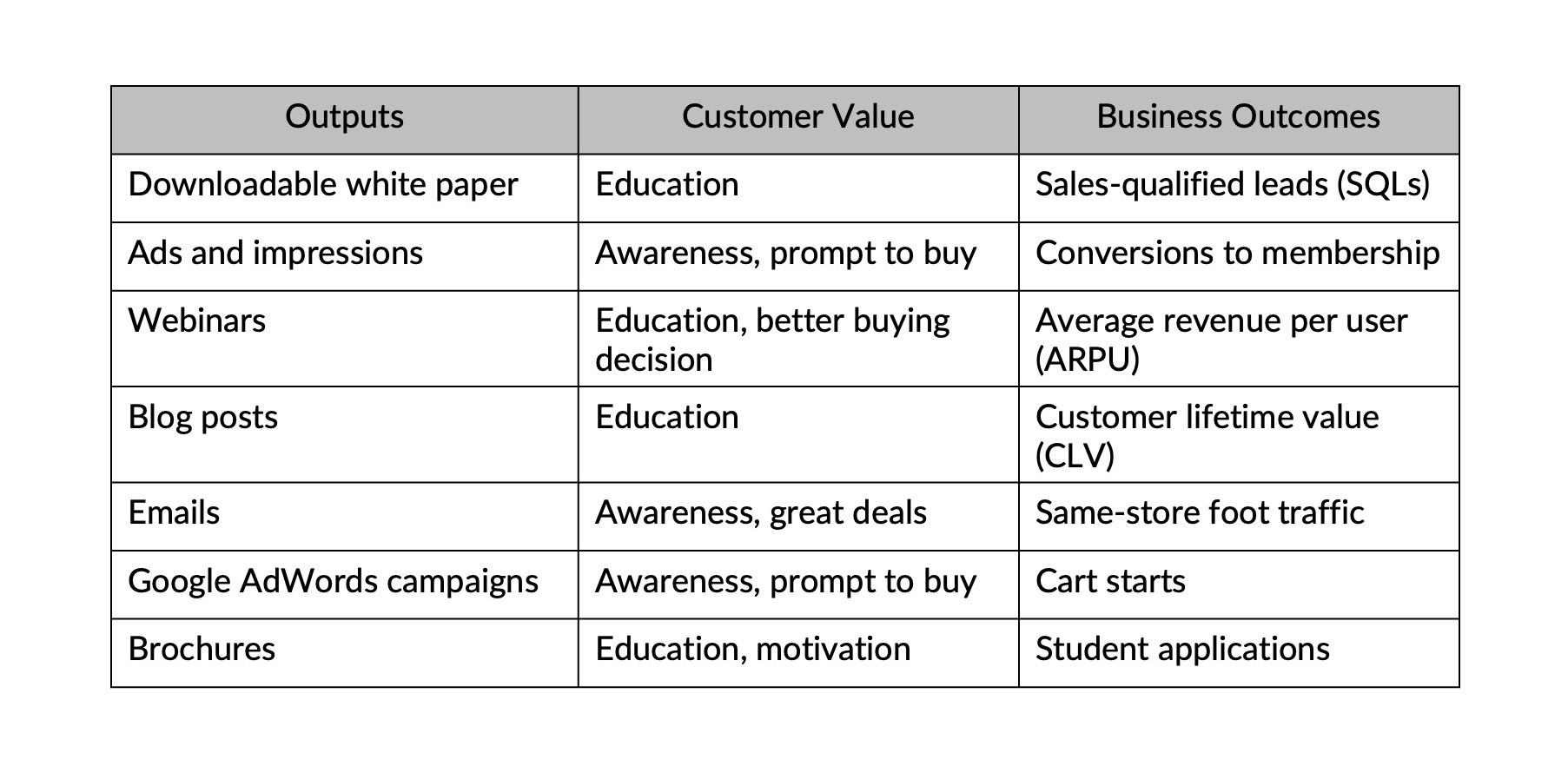
Outputs are marketing deliverables like whitepapers, landing pages, emails, advertising campaigns, and events. Outcomes are either items that deliver value to customers or value to the business. For example, businesses that create educational videos that help customers make better purchasing decisions or make better use of their products are delivering customer value.
Marketers should focus on business outcomes like greater sales volume, increased profitability, more leads, more pipeline, and higher levels of conversion rather than focusing solely on delivering outputs.
Teams that focus on customer value and business outcomes are more likely to be aligned with business units, to be proactive rather than reactive in their marketing efforts, and to produce better results.
From Campaigns to Continuous Improvement
Most marketers think in terms of campaigns. They run advertising campaigns, social media campaigns, content marketing campaigns, and multi-channel campaigns. But many of these campaigns are one-and-done. There is no time or effort to adjust the campaigns if they’re not working or to optimize them.
Continuous improvement lies at the heart of Agile. Before spending lots of money on a campaign, Agile marketers test: they create and record a hypothesis about what might work and then seek to prove or disprove that hypothesis. If the hypothesis is true, and the promotion or interaction delivers desirable business outcomes, the Agile marketer tunes the promotion or interaction to produce the best business outcomes. Only when evidence of the efficacy of an approach is in hand do they spend more money, and they continue to measure effectiveness as they scale up the campaign—knowing that some great ideas don’t scale.
From An Internal Focus to a Customer Focus
The third major shift for many marketing organizations is from an internal focus to a customer focus. This is not just cosmetic. Teams that make this shift produce more relevant content, increase conversion rates and ultimately increase customer satisfaction and loyalty.
The shift to a customer focus can have profound impacts on the business. Forrester found that the more customer-focused companies achieved compound annual growth rates 7 to 30 percentage points higher than peers in their industry who were less so. According to the most recent Deloitte study of Enterprise Customer Success (CS), 49 percent of companies with strong customer success programs see double-digit year-over-year revenue growth.
From Top-Down to Decentralized Decision-Making
In traditional organizations, all decisions are approved at the highest levels. Literally, every piece of content, campaign, and email must be signed off by the highest-level marketing person. This is inefficient. Customer-ready material sits in the approval cycle for days, sometimes weeks.
Agile organizations are different. They shift their decision-making in several ways: who makes decisions, how they are made, and how quickly they are made.
In Agile organizations, decisions are made by the person or team closest to the customer. Those individuals or teams have the most current information about what the customer wants and how a decision is likely to impact a customer.
In Agile organizations, the decision-making process also changes. Decisions are made based on data rather than on instinct or gut feeling.
Lastly, the speed of decision-making changes: Routine decisions are made in hours or a single day. More consequential decisions take longer but are made without delay. The surest way to speed up decision-making is to reduce the length of the decision path. Decisions are pushed down the organization so that they don’t have to travel through multiple layers of management. Decision paths are limited to only those departments or groups that are most impacted or most aware of the decision’s consequences rather than extended to touch every group.
Agile Marketing Methodologies
Scrum
Scrum is an iterative and lightweight project management methodology best suited to complex problems with changing requirements. It was developed to manage software projects, but marketers can use it, with a few tweaks, to manage marketing projects.
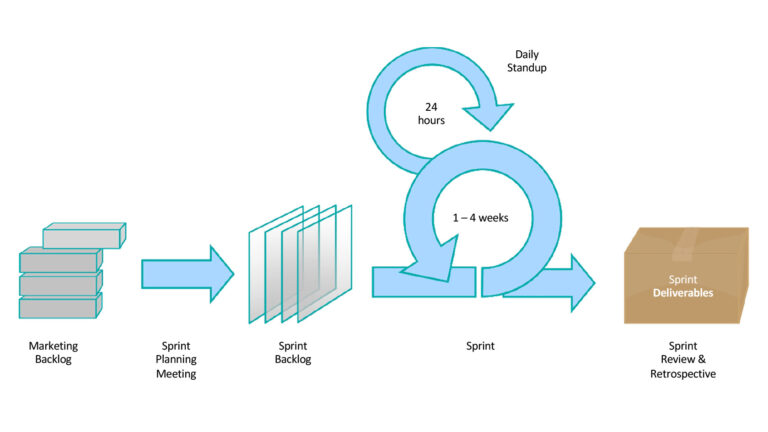
The image above illustrates the Scrum process. Scrum begins with a backlog—a list of deliverables requested by stakeholders (customers, management, sales) or developed by the marketing team to achieve marketing goals.
Every 1-4 weeks, a marketing team meets to decide which deliverables they plan to deliver in the next 1-4 weeks, a time period known as a Sprint. The name is misleading – it does not mean that the team works as fast as they can for that time. A Sprint is simply the planning interval for the most immediate deliverables. The result of this planning meeting is a list of deliverables, known as the Sprint backlog.
A Sprint may or may not have an organizing theme, sometimes called the Sprint goal. The Sprint goal can be anything that helps the team focus; it’s usually related to business priorities, projects, events, customer needs, or a portion of the customer journey. Having a Sprint goal helps each Sprint have a larger impact than if each Sprint is simply a random collection of deliverables or tasks.
The Daily Scrum is a short standup meeting where each team member answers three questions:
- What did I do yesterday?
- What will I do today?
- Are there any obstacles that stand in my way?
The team does not attempt to remove the obstacles in the daily Scrum meeting. Instead, the scrum master either pulls people aside after the meeting, allowing the other team members to engage in productive work or notes the obstacle and works to solve it before the next Scrum meeting.
Although it is called the daily Scrum, not every team holds these meetings daily. Most marketing teams hold Scrums 2-3 times per week.
Scrum also has three key roles:
- Scrum Team
- Scrum master
- Marketing Owner
Scrum Team
The fundamental unit of Scrum is a small team, generally between 4 and 9 people. Scrum teams are cross-functional as much as possible, with the members having the skills needed to deliver value. This reduces dependencies and increases the team’s autonomy.
Scrum teams differ from traditional teams in that they self-manage. There is not a leader of the team. The team collectively decides who does what, when, and how they will manage their work. For self-management to thrive, teams need:
Clear goals – the team needs to understand the problem they are trying to solve and the larger context in which they operate.
Clear boundaries – the team needs to understand where they have autonomy and which decisions are beyond their scope.
Clear accountability – the team needs to understand how each member contributes to the team.
Scrum Master
The role of the Scrum Master on a marketing team is to:
- Help the team improve its effectiveness by applying Scrum theory and practices
- Coach the team on self-management and best practices of cross-functionality
- Remove impediments to work getting done
- Organize all Scrum events and make sure they are positive and productive
Effective Scrum Masters serve as coaches and guide the team rather than serve as the enforcers of Scrum doctrine. They are committed to the Scrum foundations and values, but remain flexible to the needs of the team. Scrum Masters understand that it takes time for teams to shift to a new way of working and keep the momentum for Agile going as the teams adopt Agile.
Marketing Owner
The Marketing Owner ensures that the team delivers customer and business value. The Marketing Owner typically represents the voice of the customer and works with stakeholders and the team to set the goals for each Sprint, prioritize work items to be done during the Sprint, and determine the scope of each deliverable.
The Marketing Owner works with the team and Scrum Master to manage the Marketing Backlog. The Marketing Owner creates and clearly communicates backlog items. The Marketing Owner sets priorities, determines scope, and breaks down deliverables into chunks that can be delivered in a single Sprint.
Sprint Review
The purpose of the Sprint Review meeting is to inspect the outcome of the Sprint in order to learn and adapt in future Sprints. Sprint reviews support:
- Allowing stakeholders to review what was accomplished in the Sprint, what has changed and collaboratively decide what to do next
- Team members demonstrate completed work and answer questions
- Reviewing the Sprint goals with the team and stakeholders
- Sharing wins with the greater organization
- Reviewing work in progress
The marketing owner leads the sprint review meeting. Usually, most of the team attends to receive feedback firsthand.
Sprint Retrospective
Successful Agile teams hold regular retrospectives to improve their collaboration. They inspect what occurred in the last Sprint regarding work assignments, interactions, processes, tools, and policies like Acceptance Criteria and Definition of Done. They then adapt the process, experimenting with new ways of working.
Changes to the team’s working methods should be evaluated empirically. Do the changes make the team more efficient or effective? Do they make the work more predictable and sustainable?
There are many different formats for the Sprint Retrospective. Here are a few different ideas for how to hold a Sprint retrospective.
Kanban
According to the 2020 Kanban Guide, Kaban is “a strategy for optimizing the flow of value through a process that uses a visual, pull-based system.”
Key to this definition are the following:
- Kanban is a flow-based system. Unlike Scrum, it does not deliver work in time-based increments like Sprints.
- Kanban is visual. It relies on Kanban boards, visual reports like Cumulative Flow Diagrams, and other visual tools to represent the flow of work through the system.
- Kanban is pull-based rather than push-based. In other words, team members control when they “pull” work into their active working queue rather than having it pushed upon them by management, stakeholders, or users.
- Kanban optimizes the delivery of value. Value can be defined by the needs of the customer, organizational value, or stakeholder value, for example.
Kanban has a number of practices, including visualizing the workflow, limiting work in progress, defining process policies, and improving workflow through evolutionary change.
Visualizing the Workflow
Kanban boards help teams visualize their workflow. For example, in the board below, we can visualize the work on a campaign as it moves through 6 stages, from a request to a finished campaign.

Every workflow has a beginning, a middle, and an end, usually referred to as To Do, Doing, and Done. Each of these sections may have multiple stages or columns.
For example, some common stages in the To Do section are Requested, Approved, and Ready. Done stages could include Ready to Deploy, Deploying, and In Market or Done.
Implement WIP Limits

Marketers, often juggling multiple priorities, benefit from establishing work-in-progress (WIP) limits, which lead to a smoother and more predictable flow of work.
WIP limits the amount of work that can be taken on at any given process stage (as represented by a column on the Kanban board), or it limits the WIP for the entire team.
Limiting the amount of work or the number of items at any stage helps identify bottlenecks and encourages a culture of “done.” It facilitates identifying and resolving the approval bottleneck, that place where work backs up, waiting on the attention of an all-too-busy manager.
Document Process Policies
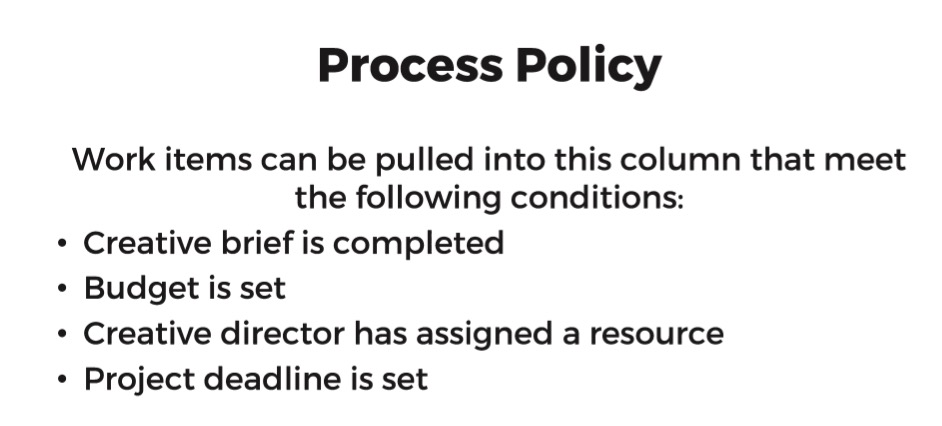
Process policies are one of the most useful and underutilized features of Kanban, particularly for marketers.
A process policy converts often unstated “rules” for how things get done in a marketing organization into documented policies, and they provide common understanding among teams.
For example, many creative teams require a creative brief, usually conforming to a standard format, before launching a project to develop new creative. Requiring a creative brief before starting on a deliverable is a process policy.
Making process policies explicit, and then enforcing them, has the following benefits:
- Everyone knows what’s expected.
- Communication improves.
- Consistency and quality rise.
- New hires learn their roles quickly.
- Flow improves.
- Rework decreases.
Improving the Workflow
Kanban teams agree to pursue improvement through evolutionary change. In other words, they make small changes and measure their impact. If the change improves efficiency, effectiveness, or quality, it is established as part of the standard way of working. If it doesn’t improve any of these measures, it is discarded.
While Kanban doesn’t have a formal retrospective event, many Kanban teams hold retrospectives using a format similar to that used by Scrum teams.
Scrumban
Many marketing organizations adopt a hybrid approach, choosing practices from Scrum and Kanban. For example, they may plan every two weeks but manage their workflow using Kanban practices like visualizing workflow, establishing WIP limits, and documenting process policies. They may also hold reviews and retrospectives, practices which are part of Scrum, but pursue improvement through evolutionary change, as in Kanban.
This hybrid approach can be very effective for marketers, and as long as they take an empirical approach to adopting practices, measuring what works and what doesn’t, they will be successful. Some teams get into trouble by mixing and matching practices based on their preferences, never trying out the full power of either Scrum or Kanban and not measuring the effectiveness of their choices. This casual hybrid approach should be discouraged.
Where Should Marketers Apply Agile?
Does Agile work for every marketing function? It depends. If we are talking about an Agile mindset, focusing on outcomes over outputs, putting customer and business value first, and so on, then yes, Agile should work for every marketing function.
If we are talking about Agile methodologies like Scrum and Kanban, they may need to be adapted to work for the different marketing functions.
Groups with control over their work, with work cycles of days or weeks, prefer Scrum. Groups with little control over priorities or timing and those with hourly or daily work cycles prefer Kanban. Many teams mix and match the practices of Scrum and Kanban and call that Scrumban.
Ideally, choosing a particular methodology is an empirical choice. Teams should experiment to determine which methodology or combination of methodologies yields the greatest throughput, effectiveness, and team satisfaction.
Here’s a table that compares the three major methodologies.
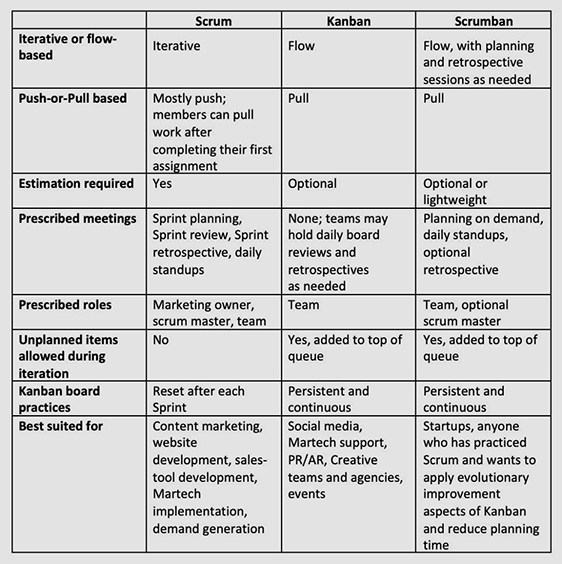
Common Agile Marketing Myths
Myth #1: Agile Marketing is about doing things quick and dirty
Agile marketing is about delivering value to the customer and the business early and often. It’s a misconception that Agile is all about speed and doing things quickly, with no controls or quality checks.
Agile seeks to eliminate activities that don’t deliver value, and if eliminating those value-free activities results in doing things more quickly, that’s good.
Agile controls the quality of activities through improved communication, documenting process policies, and testing. If everyone understands the goals of each deliverable and why a customer cares about it, that improves the quality of the work. If everyone follows documented process policies using tools like checklists, the quality of the work will improve. If every activity is tested to ensure that the value is delivered, the quality of the work will improve.
Myth #2: Agile Marketing Doesn’t Require Planning or Strategy
Agile marketing works best when priorities are clear, and everyone is on the same page regarding those priorities. Management should articulate strategies and work with teams to translate those strategies into tactics that deliver value aligned with the strategy. There are several approaches to doing this:
- Establish OKRs for every team and make sure that everyone on the team understands those OKRs.
- Hold quarterly planning sessions, known as QBRs or Big Room Planning sessions, to review progress on existing goals and strategies, inform everyone of any new goals and strategies, and plan out the first few weeks of the upcoming quarter with tactics and deliverables aligned with those goals and strategies.
- Agile leaders should spend less time dictating how to do the work and reviewing every work and every image of creative. Agile leaders should spend their time clarifying goals and strategies and providing assistance by funding critical infrastructure and initiatives, as well as clearing obstacles that come up in the execution of strategy.
Myth #3: Everyone in the Marketing Department Needs to Go Agile at the Same Time
While some marketing departments implement Agile by having everyone go Agile at the same time, it is not a best practice. Most successful Agile adoptions start with a single team learning to adapt Agile for their unique needs. Once a single team is successful, the organization can apply the lessons learned by that pilot team to broaden the adoption.
At the Agile Marketing Alliance, we prefer incremental adoption of the Agile mindset and Agile practices over a big-bang approach. A team can realize great value by adopting a single aspect of the Agile mindset, focusing on customer value and business outcomes over activity and outputs, and adopting just two Agile marketing practices: visualizing workflow and prioritizing work.
Over time, the team can adopt additional aspects of the Agile mindset and add additional Agile practices. For example, they could focus next of making customer centricity a core competency and add Agile practices like Quarterly planning sessions and user stories for every deliverable.
Myth #4: Agile Equals Scrum
Some marketers think that they don’t want to practice Agile because they equate Agile with Scrum. They observe software development teams in their organizations practicing Agile and Scrum and think that their processes can’t work for marketing.
This is a fundamental misunderstanding of both Agile and Scrum. First, the Agile mindset has nothing to do with Scrum and everything to do with good marketing. Focusing on delivering value, iterating towards value rather than launching big-bang campaigns, focusing on the customer, and distributing decision-making can all improve marketing.
For those parts of marketing that can’t plan out their cycles, they can implement Kanban. But many marketing projects can be planned out: building a new website, delivering content according to a content marketing calendar, and deploying new marketing technology. Scrum can help marketing teams deliver these projects earlier and with better results.
Myth #5: Agile is Dead or Dying
Agile is not dead. But agilists have overused buzzwords, promoted processes and transformations over people, and treated Agile like a religion rather than an evolving approach to better ways of working.
Many organizations are achieving amazing results with Agile marketing:
- By shifting from an output-based approach to marketing to an outcome-based approach, Colt Technology Services realized up to 500% improvements in some of its most critical business measurements.
- By not just focusing on getting things done faster but on delivering value faster, as measured by business outcomes, Huntington National Bank was able to increase loan application conversion rates and improve the customer experience.
- By implementing Agile technologies in its marketing organization, HID Global achieved its annual target pipeline contribution three months early and achieved growth of 116% year over year. In addition, their employee engagement scores improved from 73% to 84%.
Results like this are not achieved by a dead or dying approach.
If you’d like to learn more about why Agile is not dead or dying, check out our blog post “Is Agile Dead?”
Myth #6: Agile Marketing Only Works for Small Teams or Small Organizations
Some of the largest organizations in the world practice Agile marketing and have had huge success.
- At IBM, Agile ensured silos were first revealed and eventually mitigated or, in some cases, dismantled. Marketing teams, data analysts, and stakeholders came together driven by shared objectives.
- 3M, a global powerhouse with a staggering 55,000+ products and operations in 200 countries, deployed Agile marketing in 2016-2018 as the key change methodology. Processes that previously spanned several months were condensed into weeks. Hand-wringing over decisions was replaced with rapid testing, which saw dramatic decreases in cycle time.
The Agile Business Consortium, a UK-based organization focused on business agility, gave out awards in 2024 to companies like Vodafone, Coca-Cola, Allianz, and TBC Bank for their achievements in business agility.
The Limitations of Agile Marketing
Agile marketing is not a cure-all for everything that ails marketing. It doesn’t replace the need for good marketing fundamentals, a well-thought-out strategy, or detailed planning. It doesn’t make up for bad products that don’t deliver value to customers.
When introducing Agile marketing, we have to be careful of Agile Theater or what Boston Consulting Group calls “Illusory Agile.” Agile theater occurs when organizations go through the motions of Agile, holding standups, running Sprint planning sessions, and holding retrospectives, but they don’t focus on the fundamentals of why we do Agile in the first place: to deliver great value, sooner, with less risk and with happier marketers. In other words, they focus on Agile processes over the Agile mindset.
Agile may not go far enough in helping marketing departments develop better ways of working. Marketers may need to supplement Agile with Lean, Design Thinking, and customer-centricity. Lean helps teams identify waste and focus solely on activities that generate value to the customer. Design thinking helps companies focus on the customer experience and design products, services, and experiences that delight customers. And customer-centricity helps marketers deliver messages that resonate with customers.
How to Adopt Agile Marketing
A whole book could be written about how to adopt Agile in marketing. Here are a few guidelines:
- Focus more on building an Agile culture than on adopting Agile methodologies. The methodologies are only effective if they serve to create an Agile culture.
- Take an Incremental approach to adopting Agile rather than a big-bang transformation. People do not like to be “transformed.” They do like to be more productive, deliver great marketing results, and feel more in control of their work. Focus on what Jonathan Smart calls Better Value Sooner Safer Happier or BVSSH.
- Decide what outcomes represent success for your Agile adoption, then set a baseline for these outcomes before adopting Agile. Measure improvements to these outcome measures and celebrate the improvement. Ensure that the team understands that what you’re really trying to do is to deliver better outcomes. Agile is just a tool to help you achieve those outcomes.
- Agile leaders need to do more than write the check and show up for Agile announcement meetings. They need to ensure that the teams have everything they need to succeed with Agile. This is less about resources (although those are important) and more about clarity on the goals and the strategy. Agile leaders need to ensure that everyone understands how their daily work contributes to the organization’s goals and strategies.
- Adopt Agile from the middle outwards. The middle managers need to understand why the organization is adopting Agile marketing, be supportive of adopting Agile, and lead the adoption. Next come the leaders. Not only do they need to provide clarity on goals and strategy, but they need to adopt Agile themselves. They need to focus on outcomes, not outputs. They need to adopt a culture of continuous improvement. They need to show that customer centricity is more than a slogan but a genuine commitment. And they need to be committed to decentralized decision-making.
- Have patience. While many organizations will experience immediate benefits, the transformation from a non-Agile to an Agile organization can take 3-5 years or more of incremental improvements.
Agile Marketing Resources
Books
General Books on Agile Marketing
Agile for Everybody by Matt LeMay
The Agile Marketer: Turning Customer Experience Into Your Competitive Advantage by Roland Smart
Agile Coaching
Kanban
Kanban: Successful Evolutionary Change for Your Technology Business by David J. Anderson
Personal Kanban: Mapping Work | Navigating Life by Jim Benson
Kanban from the Inside by Mike Burrows
Kanban in Action by Marcus Hammarberg and Joakim Sunden
Scrum
Essential Scrum: A Practical Guide to the Most Popular Agile Process by Kenneth Rubin
The Scrum Guide by Jeff Sutherland and Ken Schwaber
Scrum: The Art of Doing Twice the Work in Half the Time by Jeff Sutherland
Scrumban
Scrumban – Essays on Kanban Systems for Lean Software Development by Corey Ladas
The Scrumban [R]Evolution by Ajay Reddy
Testing and Optimization
Adapting to Change
The Innovator’s Dilemma: When New Technologies Cause Great Firms to Fail by Clayton M. Christensen
The Innovator’s Solution: Creating and Sustaining Successful Growth by Clayton M. Christensen
Miscellaneous
Turn the Ship Around!: A True Story of Turning Followers into Leaders by L. David Marquet
Articles
Agile & Agility
Explaining Agile (3 Laws of Agile) (Forbes article) –Steve Denning
6 Anti-Patterns that May be Undermining Your Agile Marketing Efforts by Andrea Fryrear
Develop Your Marketing Strategy with an Agile Approach – Gartner
Agile Content Marketing by Ben Sailer
VUCA (Volatility, Uncertainty, Complexity, and Ambiguity)
VUCA video by Simon Sagmeister & Reza Razavi
VUCA 2.0: A Strategy for Steady Leadership in an Unsteady World
Agile Teams
The Five Trademarks of Agile Organizations – McKinsey
Unleashing the Power of Small, Independent Teams – McKinsey
75% of Cross-Functional Teams are Dysfunctional – Harvard Business Review
Failed #Squadgoals by Jeremiah Lee
6 Tips for Developing Cross-Functional Teams – Project Manager.com
The nine traits of future-ready companies – McKinsey
The Dead Beatle Problem: Designing Strategic Weaknesses Into Organizations by Michiel van Gerven
IDEO CEO Tim Brown: T-Shaped Stars: The Backbone of IDEO’s Collaborative Culture
Cross Functional Doesn’t Mean Everyone Can Do Everything
Drexler-Sibbet Team Performance Model by Fadi Stephan
OKRs and Other Metrics for Agile Teams
OKRs for Agile Marketing Teams
Why Agile Often Fails: No Agreed Metrics by Steve Denning
Kanban
Getting Started with Kanban by Kanbanize, a tool vendor
Portfolio Kanban
Portfolio Kanban according to Scaled Agile (SAFe)
Case study on the implementation of Portfolio Kanban
Scrum
Agile Retrospectives: Making Good Teams Great
A Quick Guide to All Things Scrum
What is Scrum (An Agile Cartoon)
Testing and Optimization
Gopractice.io – a simulator for learning data-driven growth
How to Master A/B Split Testing Quickly by Neil Patel
Creating an Agile Culture
Being Agile vs Doing Agile, Why is it important to differentiate!? by Rash Khan
The Anatomy of a Modern Marketing Org by Melissa Sargeant
Miscellaneous
Competing for Buyer Attention in the Age of Agility by Meghan Brockmeyer

